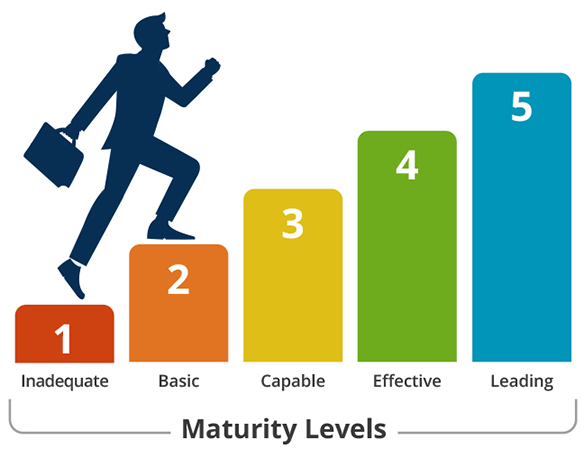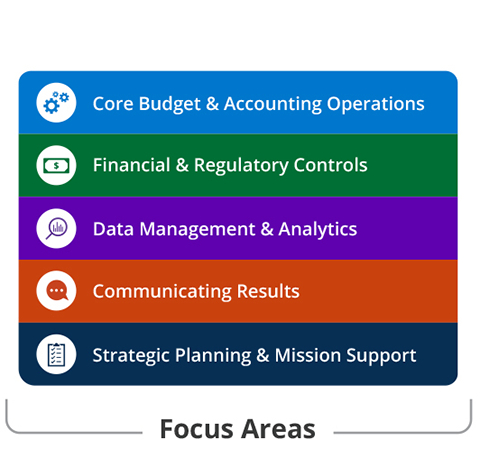
Instructions
Review each of the five Financial Management Focus Areas and check the box that most closely matches the state of your agency's operations.
Scroll down below the gold “privacy” banner to start the assessment.
Alternatively, you can download and print the Printable Self-Assessment Worksheet.


Your privacy is important to us.
This self-assessment tool is anonymous.
We will not store or track any of your information.
Your Results
From your self Assessment
Inadequate
- Legacy, customized system
- Lack of automated interfaces requiring manual re-entry
- No plans to modernize
- FISMA financial findings exist
- Heavy reliance on manual processes that lead to rework
- No customer service
1. Core Budget & Accounting Operations
You scored this area as "Inadequate"
How to improve your score:
Basic
- Legacy, customized system
- Limited automated interfaces
- OMB-approved modernization plan
- FISMA financial findings exist
- Reliance on manual processes with efforts underway to automate
- Limited customer service
1. Core Budget & Accounting Operations
You scored this area as "Basic"
How to improve your score:
Capable
- Modern COTS product with limited customizations
- Batch interfaces
- No FISMA financial findings
- Mix of manual and automated processes
- Established customer service processes
1. Core Budget & Accounting Operations
You scored this area as "Capable"
How to improve your score:
Effective
- Modern COTS products with no customization
- Mix of batch and real-time system-to-system interfaces
- No FISMA financial findings
- Strategic use of third-party arrangements
- Automated end-to-end processes with predominantly real-time interfaces
- Self-service capabilities
1. Core Budget & Accounting Operations
You scored this area as "Effective"
How to improve your score:
Leading
- Modern COTS product with no customization
- Real-time system-to-system interfaces
- No FISMA financial findings exist
- Fully automated, real-time end-to-end processes
- Self-service capabilities widely adopted
1. Core Budget & Accounting Operations
You scored this area as "Leading"
How to improve your score:
Inadequate
- Modified opinion (Disclaimer or Adverse)
- Risks occasionally discussed
- No formal process to manage risks
- Periodic mission failure due to lack of preparedness
2. Financial & Regulatory Controls
You scored this area as "Inadequate"
How to improve your score:
Basic
- Modified opinion (Qualified)
- Noncompliant with one or more laws and regulations
- Risks identified and managed in a siloed manner
- Ad hoc process to identify and document risks
- Major risks averted in a reactive, inefficient manner
2. Financial & Regulatory Controls
You scored this area as "Basic"
How to improve your score:
Capable
- Unmodified opinion with one or more material weaknesses
- Noncompliant with one or more laws and regulations
- Risks identified and managed across the agency
- Management understands crosscutting agency risks
- Established mitigating controls minimize risk exposure
2. Financial & Regulatory Controls
You scored this area as "Capable"
How to improve your score:
Effective
- Unmodified opinion no material weaknesses or significant deficiencies
- Compliant with laws and regulations
- Formal ERM program to identify, document and manage risks across the agency
- Mission programs inherently manage risk
- Risk mitigation enhanced through diagnosis of lessons learned
2. Financial & Regulatory Controls
You scored this area as "Effective"
How to improve your score:
Leading
- Sustained (three years) unmodified opinion
- No material weaknesses or significant deficiencies
- Compliant with laws and regulations
- Mature ERM program to identify, document and manage risks across the agency and with external stakeholders
- Culture of proactive risk management
- Agency routinely implements preventive controls and risks rarely become issues
2. Financial & Regulatory Controls
You scored this area as "Leading"
How to improve your score:
Inadequate
- Standard financial reports
- Data is unreliable
3. Data Management & Analytics
You scored this area as "Inadequate"
How to improve your score:
Basic
- Standard financial reports with limited ad hoc capability
- Data reconciled and validated periodically
3. Data Management & Analytics
You scored this area as "Basic"
How to improve your score:
Capable
- Standard ad hoc reporting capabilities for financial data
- High quality data reconciled and validated regularly
3. Data Management & Analytics
You scored this area as "Capable"
How to improve your score:
Effective
- Standard, ad hoc user-driven reporting capabilities
- Integrated financial and program data
3. Data Management & Analytics
You scored this area as "Effective"
How to improve your score:
Leading
- Standard, ad hoc, user-driven, analytic reporting capabilities
- Agency-wide access to integrated financial and program data
- Ability to perform advanced analytics (predictive, evidence-based decision-making, etc.)
3. Data Management & Analytics
You scored this area as "Leading"
How to improve your score:
Inadequate
- No structured internal communication function
- Does not meet financial reporting deadlines
4. Communicating Results
You scored this area as "Inadequate"
How to improve your score:
Basic
- Operational goals and performance metrics communicated to FM personnel
- May not meet financial reporting guidelines
4. Communicating Results
You scored this area as "Basic"
How to improve your score:
Capable
- Organizational performance communicated to agency personnel
- Meets reporting deadlines
4. Communicating Results
You scored this area as "Capable"
How to improve your score:
Effective
- Organizational performance communicated to agency personnel and customers
- Meets financial reporting deadlines
4. Communicating Results
You scored this area as "Effective"
How to improve your score:
Leading
- Organizational performance communicated to agency personnel and customers on a regular basis
- Meets financial reporting deadlines
4. Communicating Results
You scored this area as "Leading"
How to improve your score:
Inadequate
- No documented FM goals or performance metrics
- Unable to produce cost of agency programs
5. Strategic Planning Mission Support
You scored this area as "Inadequate"
How to improve your score:
Basic
- FM goals and performance metrics documented
- No performance targets exist
- Produces macro level cost of agency programs with no insight on cost detail
5. Strategic Planning Mission Support
You scored this area as "Basic"
How to improve your score:
Capable
- FM goals and performance metrics documented
- Performance targets exist
- Some performance target met
- Produced detailed annual cost of agency programs and understands cost drivers
5. Strategic Planning Mission Support
You scored this area as "Capable"
How to improve your score:
Effective
- FM goals and performance metrics documented
- Performance targets exist
- Most performance targets met
- Regularly produced detailed cost of agency programs and leverages internal benchmarking
5. Strategic Planning Mission Support
You scored this area as "Effective"
How to improve your score:
Leading
- FM goals and performance metrics demonstrate year-over-year improvement
- Performance targets updated annually
- Detailed cost estimating
- Forecasting, and external benchmarking drive program decisions
5. Strategic Planning Mission Support
You scored this area as "Leading"
How to improve your score:
NOTE: To retake the test please refresh the page.
Last modified 01/30/23
